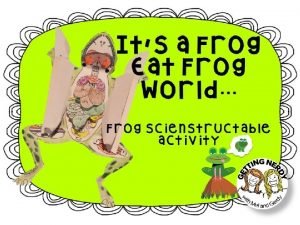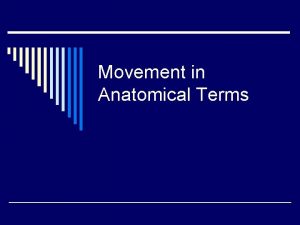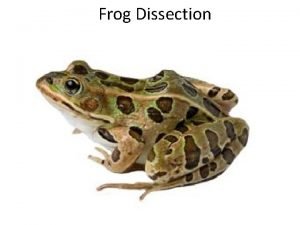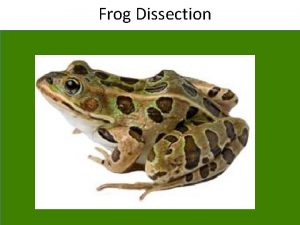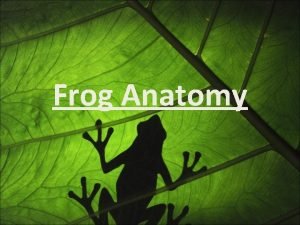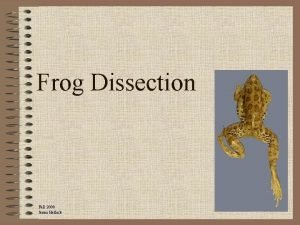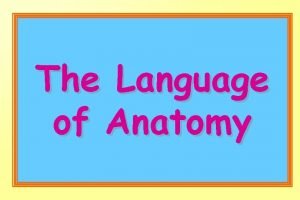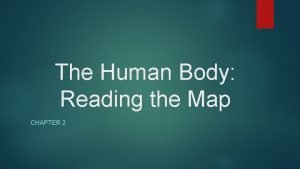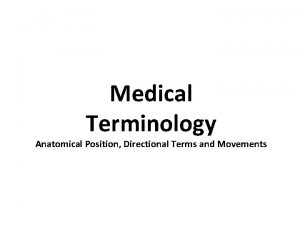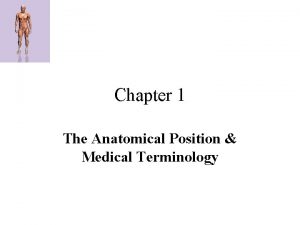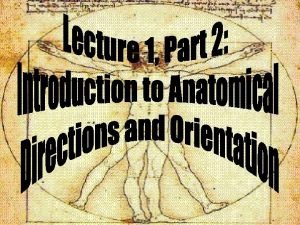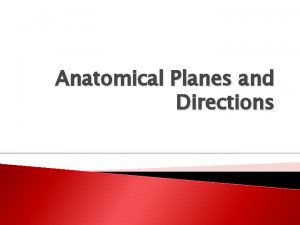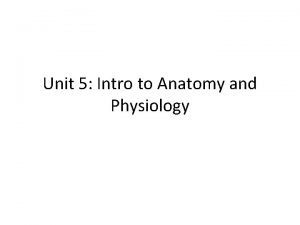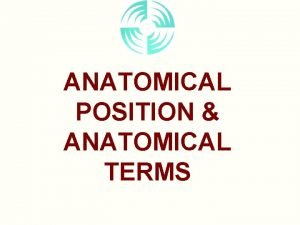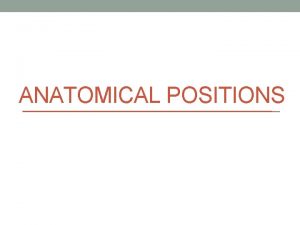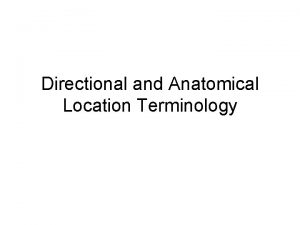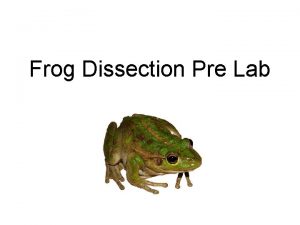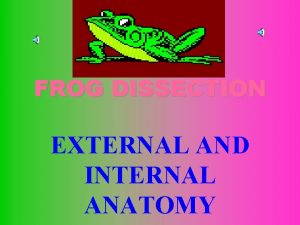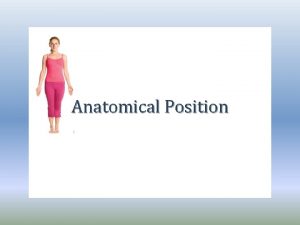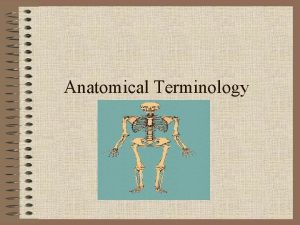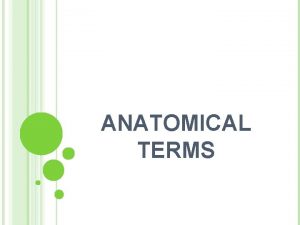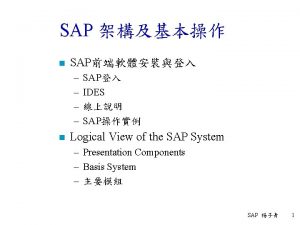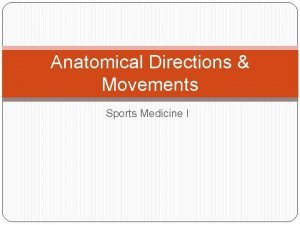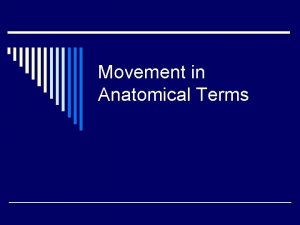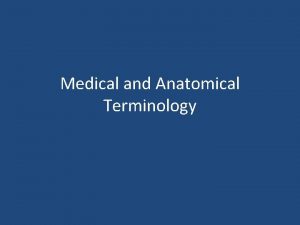Frog External Anatomy SAP Standard Anatomical Position Dorsal


















- Slides: 18

Frog External Anatomy

SAP Standard Anatomical Position • • Dorsal = BACK Ventral = CHEST Anterior = HEAD Posterior = BUTT

Dorsal and Ventral Characteristics • How do they differ in color? Dorsal side color? Pattern? Ventral side color? Pattern? • The hind legs. How many toes are present? Webbed? • The forelegs. How many toes are present? Webbed? • Measuring the frog -- from the tip of the head to the end of the frog’s backbone (does not include the legs). ~10 -12 cm

Features of the Head Frog eyes have a nictitating membrane • clear membrane attached to bottom of eye • used for protection of the eye. • What color is the nictitating membrane? • What color is the eyeball? Just behind the eyes is a circular structure called the tympanic membrane. • used for hearing • the diameter (distance across the circle) of the tympanic membrane. • Diameter of tympanic membrane ~1 cm Feel the frog’s skin. Is it scaly or is it smooth? smooth

Frog Mouth Anatomy • The tongue – Attaches to the front or the back of the mouth. forked – Flips out to catch prey • The esophagus – in the center of the mouth, toward the back, a single round opening – leads to the stomach • The Eustachain Tubes – Close to the angles of the jaw, two openings, one on each side. – to equalize pressure in the inner ear while the frog is swimming – Leads to the tympanic membrane • The Glottis – Just behind the tongue, a slit like opening. – the opening to the lungs – frog breathes and vocalizes with the glottis • Teeth – – • The frog has two sets of teeth The vomerine teeth are found on the roof of the mouth. The maxillary teeth are found around the edge of the mouth. Both are used for holding prey, frogs swallow their meals whole and do NOT chew. Nostrils (External and Internal Nares) – Two tiny openings on the roof of the mouth

LABEL the structures on the mouth • Nostrils • Maxillary Teeth • Vomerine Teeth • Esophagus • Eustachian Tubes • Glottis • Tongue

Structure Vomerine teeth Function Location Trap prey Roof of mouth Eustachian tubes Equalize pressure in ear Back corners of mouth Nictitating Membrane Protect eyes in water Lower eye lid Tympanic Membrane Eardrum – for hearing Behind eye on side of head Esophagus Connect mouth to stomach Back center of mouth Seal off trachea that leads to lungs Bottom of mouth in front of esophagus Glottis


Internal Anatomy Digestive, Circulatory & Respiratory Systems • Fat Bodies Spaghetti shaped structures that have a bright orange or yellow color • Peritoneum A spider web like membrane that covers many of the organs, you may have to carefully pick it off to get a clear view • Liver The largest structure of the body cavity. This brown colored organ is composed of three parts, or lobes. The right lobe, the left anterior lobe, and the left posterior lobe. The liver is not lobe primarily an organ of digestion; it does secrete a digestive juice called bile. Bile is needed for the proper digestion of fats. Bile is emptied into the gall bladder which then empties into the duodenum. • Heart at the top of the liver, the heart is a triangular structure. The left and right atrium can be found at the top of the heart. A single ventricle located at the bottom of the heart. The large vessel that extends out from the heart is the conus arteriosis.

• • Lungs underneath & behind the heart & liver. They are two spongy organs. Lungs attach to the trachea via tubes called bronchi. Gall bladder a small green sac under the liver which stores bile and then releases it into the duodenum via the bile duct. Stomach Curving from underneath the liver is the stomach. The stomach is the first major site of chemical digestion. Frogs swallow their meals whole. The digestion stomach connects to the small intestine. The pyloric sphincter valve regulates the exit of food from the stomach Pancreas – This glandular organ is located within the curve of the stomach. On preserved frogs it may not be easy to find, as the gland breaks down. It secretes insulin, which is needed for the proper breakdown of sugar. Small Intestine Leading from the stomach. The first straight portion of the portion small intestine is called the duodenum, the curled portion is the ileum. A membrane called the mesentery holds the ileum together. Note the blood vessels running through the mesentery; they will carry absorbed nutrients away from the intestine. Absorption of digested nutrients occurs in the small intestine. Large Intestine the small intestine will widen into the large intestine. The large intestine is also known as the cloaca in the frog. The cloaca is the last stop before wastes, sperm, or urine exit the frog's body. (The word "cloaca" means sewer. ) Last is the anus.

• Spleen—In the folds of the mesentery is a dark red spherical object that serves as a holding area for blood, where harmful particles can be filtered out for the immune system. • Esophagus where the stomach gets smaller at the bottom of the esophagus. The esophagus is the tube that leads from the frog’s mouth to the stomach. Stomach & Intestine The texture and ridges on the inside of the stomach is referred to as rugae. Rugae help to break down food. Measuring the Small intestine: If you remove the small intestine and stretch it out and measure it you’ll find it is as long if not longer than the length of your frog. The Heart -- just above the liver in the center The dark reddish brown vessel on the front of the heart is the conus arteriosis, which sends blood to the body. On the back are the openings for the anterior and posterior vena cava, which return blood to the heart. How many chambers does the frog heart have? THREE

Urogenital System • • • The frog’s reproductive and excretory system is combined into one system called the urogenital system. combined Kidneys – flattened bean shaped organs located at the lower back of the frog, near the spine. They are often a dark color. The kidneys filter wastes from the blood. Often fat bodies are attached to the kidney. Testes – in male frogs, these organs are located at the top of the kidneys, they are pale colored and round. Oviducts – females do not have testes, though you may see a curly q type structure around the outside of the kidney, these are the oviducts. Oviducts are where eggs are produced. Bladder – An empty sac located at the lowest part of the body cavity. The bladder stores urine. Cloaca – mentioned again as part of the urogenital system – urine, sperm and eggs exit here.

Female Fat Bodies Oviducts Kidneys Cloaca Ovary Bladder

Male Fat Bodies Testes Kidneys Cloaca Bladder

Post Lab Questions 1. The membrane holds the coils of the small intestine together: MESSENTARY 2. This organ is found under the liver, it stores bile: GALL BLADDER 3. Name the 3 lobes of the liver: RIGHT LOBE, LEFT ANTERIOR LOBE, LEFT POSTERIOR LOBE 4. The organ that is the first major site of chemical digestion: STOMACH 5. Eggs, sperm, urine and wastes all empty into this structure, the “sewer”: CLOACA 6. The small intestine leads to the: LARGE INTESTINE/CLOACA 7. Blood returns to the heart via the anterior and posterior VENA CAVA 8. Yellowish structures that serve as an energy reserve: FAT BODIES 9. The first part of the small intestine (straight part): DUODENUM 10. After food passes through the stomach it enters the: SMALL INTESTINE

Post Lab Questions 11. A spiderweb like membrane that covers the organs: PERITONEUM 12. Regulates the exit of partially digested food from the stomach: PYLORIC SPHINCTER 13. The large intestine (cloaca) leads to the URINARY BLADDER / ANUS (the opening to the outside ) 14. Organ found within the mesentery that stores blood: SPLEEN 15. The largest organ in the body cavity: LIVER 16. Vessels that carry blood to and from the lungs: PULMONARY ARTERIES 17. The esophagus leads to the STOMACH the glottis leads to the LUNGS 18. Bile moves from the gall bladder to the duodenum through the COMMON BILE duct. 19. The organ located near the stomach that makes insulin: PANCREAS 20. The large vessel that carries blood away from the heart: CONUS ARTERIOSIS

A Esophagus B Left Atrium C Stomach D Pancreas E Pyloric Sphincter F Anus G Right Atrium H Lungs I Heart J Liver K Gall Bladder L Small Intestine M Large Intestine/ Cloaca N Conus Arteriosis P Spleen

NOW WHAT? • Make sure all labs are finished and turned in by Wednesday AFTER YOU TAKE YOUR FROG TEST – Virtual Frog – External Anatomy – Internal Atatomy • Check the grade sheets to see if you have any missing assignments – tomorrow will be the holiday known as Yellow Card Wednesday (this holiday is followed by ASD Thursday) • Complete the Frog Review Puzzle in preparation for tomorrow’s test • Study the online activities 23 – 26 • Get papers from boxes and organize folders
 Frog common femoral vein function
Frog common femoral vein function Fundamental position vs anatomical position
Fundamental position vs anatomical position Regional anatomical terms
Regional anatomical terms Function of dissecting tray
Function of dissecting tray Reproductive organ of frog
Reproductive organ of frog Frog external anatomy
Frog external anatomy Frog body parts and functions
Frog body parts and functions Frog external anatomy
Frog external anatomy External nares of a frog
External nares of a frog Anatomical directions of frog
Anatomical directions of frog First position second position third position
First position second position third position Frog muscles
Frog muscles Erect anatomical position
Erect anatomical position Anatomical position supine
Anatomical position supine Medical body terms
Medical body terms Anatomical position medical term
Anatomical position medical term Palms posteriorly positioned
Palms posteriorly positioned Definition of plane in anatomy
Definition of plane in anatomy Body planes and axes
Body planes and axes
